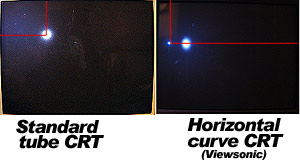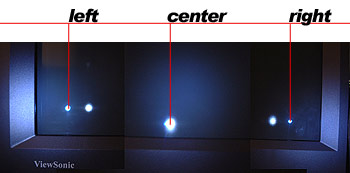We talked about flat face CRT displays a little bit
already, and with the help of the "Light Test" you can determine for
yourself just how flat one of these types of monitors really is. If you look at the
images to the right, you can see what are two full CRT screens compared side by
side with a light reflecting off the screen. Each of the photos was taken in a
darkened room a few feet away from the monitors.
If you look at the
images to the right, you can see what are two full CRT screens compared side by
side with a light reflecting off the screen. Each of the photos was taken in a
darkened room a few feet away from the monitors.
The small white LED light was directed at the upper left corner of each
screen, and as you can see, the number of reflections weren't exactly the
same.
The standard tube CRT monitor is made by ADI Microscan, and in that image the reflected light
is one large blurry area - light is not separated because the inner and outer surfaces
of the glass are parallel, but remember this is a standard curved screen.
The flat face monitor screen on the right is the Viewsonic
P95f+B, and the red intersecting lines converge on the actual surface reflection of the white LED. The second large blurry reflection to the right is the
white light reflecting off of the inner screen surface, which is slightly curved in the
horizontal plane. From this, we can conclude that while the outer surface of the
display is indeed flat, the inner surface curves slightly in the horizontal axis.
For the sake of argument, if the inner surface of the screen had curved in
both the horizontal and vertical axis the blurry reflection would have been
slightly lower than the actual surface reflection, which is sharp.

In the next example, we've
taken three photos of the Viewsonic monitor with light at different positions along the
width of the screen to illustrate the point more clearly.
As you can see, at the left hand side of the screen the inner reflection
(blurry spot) is sightly to the right of the surface reflection which is sharp.
At the center of the Viewsonic P95f+B display both reflections are superimposed
over each other because the inner and outer surfaces of glass are parallel (this
also helps explain why the screen is just a bit sharper at the center).
Lastly, the far right image shows the blurry inner
reflection just to the left of the surface reflection as the internal curvature continues. Since the light test was done
at the bottom of the screen, any vertical curvature would have brought
the blurry reflections up slightly, but that isn't the case so we know the
screen only curves in one axis.

